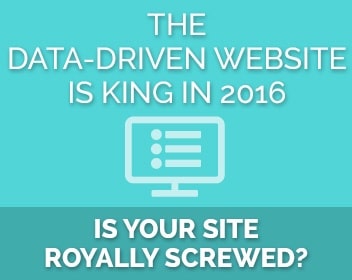6 September 2016
The Data Driven Website Is King In 2016 – Is Yours Royally Screwed?
 The days of putting a website up and calling it “done” are over.
The days of putting a website up and calling it “done” are over.
Search engines and visitors all demand new information, updated content, streamlined design. It’s hard enough getting this right the first time, but keeping it can feel impossible.
But here’s the secret: if it seems hard, it’s because you might be doing it the hard way.
There’s a much easier way to stay ahead of the curve. All you need to do is know where the curve is going.
It seems impossible. But is it?
No. It isn’t. Because your website can collect all the data you need to make the best decisions on what will allow it to perform its best. How?
We dive into that with this blog post.
The modern website in 2016 is more than just a business card on the web listing your services, your team, and a contact form. It’s a hub of all your digital marketing – the front door to your business for many of your customers and the first place they turn when they have questions.
It’s also more than just static pages.
These days it’s all about data. Visitor data. Interaction data. Optimization data. Conversion data. It’s all boiled down into numbers, and numbers can be measured.
What does that mean for you? Smarter decisions. How?
Validating Changes
Some say “trust your gut”, a better saying is “test your gut”.
Intuition can take you pretty far, and being able to know if your intuition is heading in the right direction is definitely the best way to go.
By tracking your visitors you can make better-informed decisions on what is and is not working on your website.
These can be broad, sweeping changes like new pages and content or small ones like changing the color of a button.
The point is, you decide what to do to your website, and let your website – not your gut – decide if it’s working or not.
What’s a way to do this?
Conversion Tracking
A conversion is moving someone further down the buyer’s journey, that could be from a visitor to a lead, a lead to a prospect, etc.
Conversion tracking is a simple metric, but a powerful one. It tracks how many people visit a page, then measures how many of those converted by taking a defined action. This can be filling out a form, buying a product, scheduling a demo, etc.
By tracking this metric, you can see how the performance of your website is compared to visits, not just a blind number. It gives context.
50 purchases in a day can seem great. Unless you run a website like Apple that sees thousands of visitors every minute. Instead, you want to know what percentage was converted.
So with being able to test conversions, how can you use this on your site?
A/B Testing
There isn’t much that’s more powerful than A/B testing.
A/B testing is making a change to a web page, directing part of the traffic to that web page, and measuring the results.
Let’s say you wanted to test a different copy on a page that has a conversion form on it. You would create a second version of that page and send a small, but measurable, amount of traffic to that page with the change.
After a period of time, you can then track the conversion rate and see which performed better. If it does, you push that update into the main version and start another experiment. If it doesn’t, you log it and throw it away.
A/B testing allows you to continually optimize your website in a measured way.
This is just the start. Heatmaps, conversion paths, contextual content – the modern data-driven website is a machine that can power your online identity. It’s more than just images and text on a screen, it can be a focal point for your digital marketing.
When you look at your own site, do you see the same potential?







